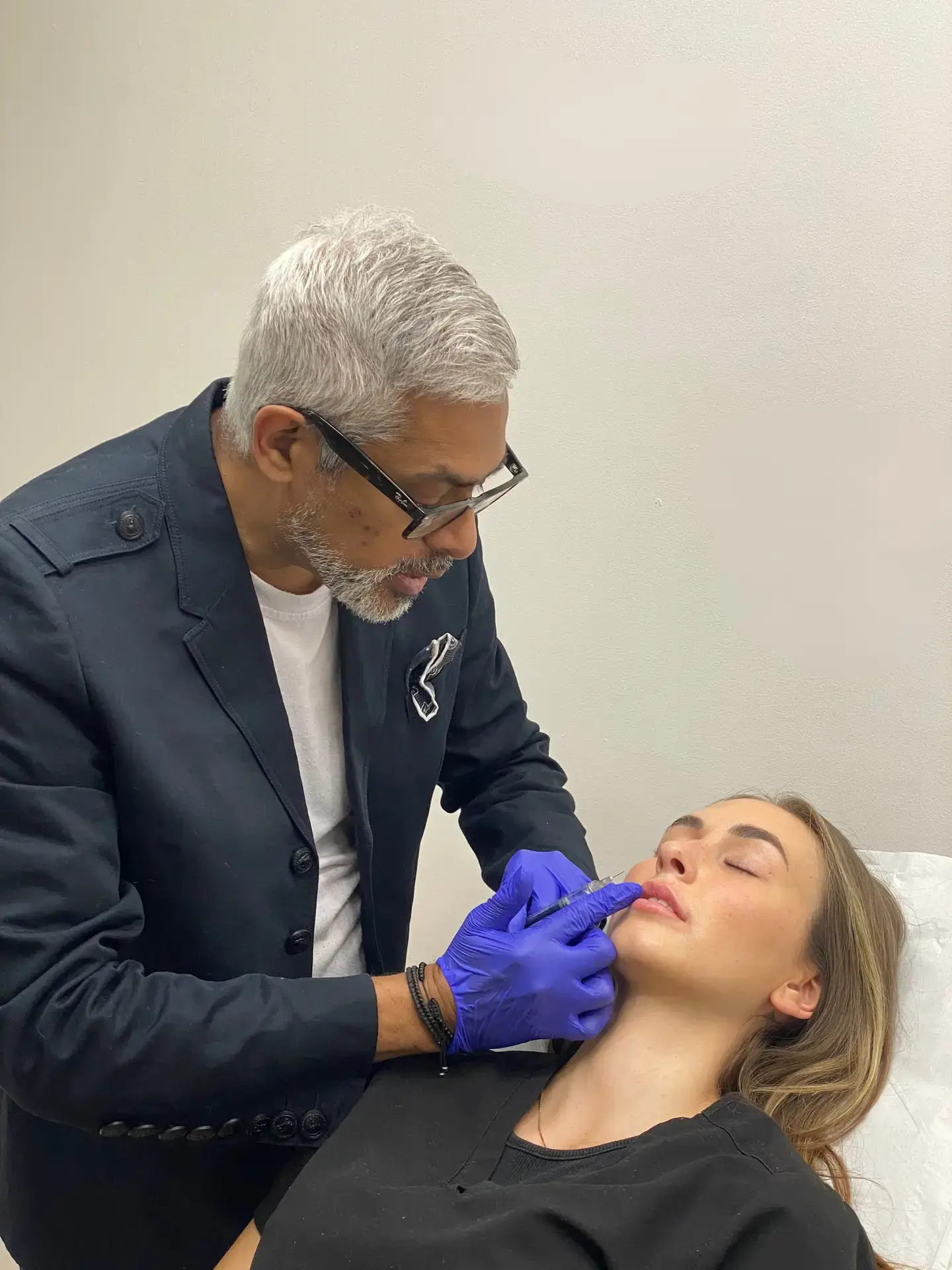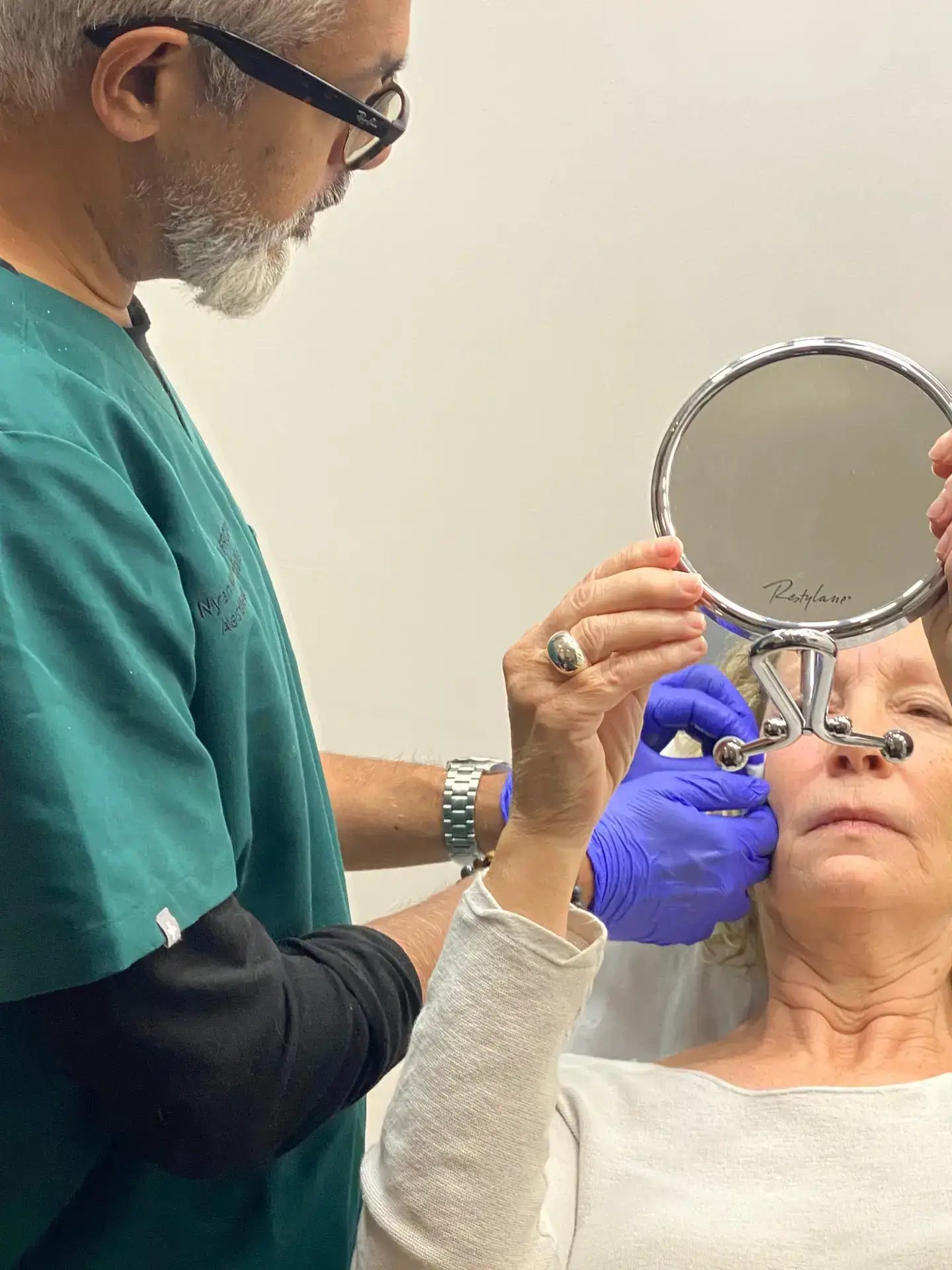Dermal Fillers in Montreal: Redefine Your Facial Harmony
Why choose dermal fillers to enhance your facial balance?
Dermal fillers are injectable gels made of hyaluronic acid that help restore lost volume, smooth wrinkles, and enhance facial proportions.
This non-surgical treatment delivers immediate, natural, and progressive results, tailored to your features and aesthetic goals.
At Clinique M Rockland in Montreal, each treatment plan is fully personalized and performed exclusively by our expert physicians.
Thanks to their mastery of facial anatomy and a measured, subtle approach, you’ll achieve a harmonious, elegant result, refined and never excessive, staying true to your natural beauty.
Because a balanced face shouldn’t be noticed — it should be felt.
What Dermal Fillers visibly improve:

Volume loss

Lips

Facial laxity and structural loss

Deep lines and wrinkles

Overall facial rejuvenation
2 syringes = 50% off the M Instant Anti-Wrinkle treatment
Black Friday offers available until December 2.
Every point brings you closer to your next treatment.
Page summary
- What results can filling agents achieve?
- Treatable areas
- Rates & Treatment plan
- What harmonization can reveal about you
- What products are used at Clinique M?
- At what age should facial harmonization be considered?
- What can you expect after treatment?
- What our patients say
- Why choose Clinique M?
- Frequently asked questions
Which results can be achieved with dermal fillers?
- Smoothed wrinkles and restored volume
A more rested, refreshed appearance — signs of aging soften without freezing your expressions.
- Redefined contours and balanced profile
Cheeks, jawline, chin — your facial structure regains definition and harmony.
- Lift effect without surgery
Subtle injections create a gentle tightening effect, no scalpel or downtime required.
- Natural, symmetrical lips
Redefined, plump, and harmonious lips — always true to your natural expression.
- Brighter, more open eyes
Hollows and dark circles are softened — the face looks revitalized and luminous.
Result: a cohesive, expressive, and radiant look that still feels like you.
Areas that can be treated
Every face tells a different story — that’s why harmonization is never about one area alone.
Hyaluronic acid–based dermal fillers can precisely target multiple facial zones to restore lost volume, soften features, and enhance natural symmetry.
Depending on your needs, the treatment may focus on one or several of these areas:
Cheekbones
To restore volume and create a lifting effect.
Cheeks
To correct volume loss and give a more youthful appearance.
Lips
To add volume, redefine contour and improve balance with the rest of the face.
Nasolabial folds
To soften the folds between the nose and mouth.
Temples
Fills hollows and restores a fuller, more youthful appearance.
Jawline
To define and refine the oval of the face.
Chin
To project and balance the profile of the face.
Dark circles
To reduce the appearance of dark circles and puffiness under the eyes.
Rates & Treatment plan
Neuromodulators + M Instant Anti-Wrinkle
The winning combo: softened wrinkles now, smoother skin long-term.
An instant effect, a result that improves week after week.
40 units of neuromodulators
$1150 $1370 -30% M INSTANT ANTI-WRINKLEM Radiance Boost Protocol
Exclusive Clinique M protocol that combines Hollywood Peel Spectra and targeted vitamin therapy.
Together, they purify, stimulate and nourish the skin to restore immediate radiance and freshness.
1 session
$500Complete package - 3 sessions
$1200 $1500 20% OFF
A medical, artistic, and personalized approach
Under the supervision of Dr. Nyan Narine, our physicians and nurse injector combine medical rigor with aesthetic precision.
Each injection is performed with care, attentiveness, and a global vision to achieve natural, harmonious results.
Facial harmonization at Clinique M is the perfect balance between science and beauty.
Products used at Clinique M: Restylane® — the global gold standard
We use only Restylane dermal fillers, developed by Galderma, a world leader in dermatological aesthetics.
Why this choice makes a difference:
- Clinically proven safety and effectiveness
- Tailored textures for each area (soft for lips, firm for contours)
- Over 65 million treatments performed worldwide
- Approved by Health Canada and the FDA


At what age should you consider dermal fillers?
There’s no “perfect” age — only the right time to restore balance.
From your thirties onward, early signs of skin laxity may appear; dermal fillers help preserve facial freshness and slow visible aging.
For younger patients, a targeted approach can correct asymmetries or enhance facial definition naturally and preventively.
At Clinique M Rockland, it’s your morphology, not your age, that guides our recommendations.
At Clinique M, it’s your body type, not your date of birth, that guides our recommendations.
What to expect after a filler session?
- Immediate results visible right after treatment
- No downtime — resume normal activities immediately
- Long-lasting effects, from 6 to 18 months depending on the area
- Guaranteed natural outcome — refreshed glow without obvious transformation
That moment when you look in the mirror and feel that something has changed — without knowing exactly what — that’s the sign of a successful harmonization.

Club M
Turn your care into rewards
At Clinique M, every treatment is also a way to earn tangible rewards through our Club M Loyalty Program.
For every dollar spent on your treatments, you accumulate Club M points that can be redeemed as credits toward future visits — across any treatment category.
Did you know?
Many of our clients forget they’ve already accumulated points over time! Contact us to check your balance — your next treatment might already be partially paid for.
New to Clinique M?
Good news — joining Club M is free and without commitment.
Plus, receive 500 welcome points (a $25 value) upon registration.

Existing customer
Earn points with every visit.
- Every $1 spent = 1 Club M point
- 1000 points = $50 beauty credit

New customer
Join our Club M program and receive $25 off with your free registration.
- Every $1 spent = 1 Club M point
- 1000 points = $50 beauty credit
Unlock your beauty rewards with Club M.
What our patients say
"I wasn't trying to look 10 years younger. I just wanted to look less tired.
Dr Narine knew exactly where to intervene: cheekbones, furrows, a little on the chin. Result: I feel better, more aligned with my self-image.
No one has asked me if I've had injections, but I'm often told I look good."
"I'd been hesitating for years. Fear of a frozen effect or of not recognizing myself anymore.
But from the first meeting with Dr Bouafad, I felt I was in good hands.
We worked in stages: temples, jawline, and a little lip enhancement.
I've got my contours back and that's exactly what I wanted."
⭐️⭐️⭐️⭐️⭐️
Why choose Clinique M for your injections?
Certified medical expertise
Injections are performed exclusively by our 3 injection physicians:
- Dr Nyan Narine, Medical Director, specialist in aesthetic medicine, bioregeneration and hair restoration
- Dr. Nassima Bouafad, family physician specializing in medical and aesthetic dermatology
- Dre Thi My Linh Tran, family physician specializing in medical and aesthetic dermatology
Natural, balanced results
Our approach aims to correct gently, without freezing or transforming.
You remain yourself, with that little something extra.
Rigorous follow-up and personalized advice
We support you before, during and after treatment.
You'll receive a comprehensive assessment, clear recommendations and post-injection follow-up.
Clinique M
Excellence in aesthetic medicine for your authentic beauty
Frequently asked questions
Facial harmonization is a customized approach to balancing facial features using hyaluronic acid-based fillers. The aim is to enhance your natural beauty without transforming your face.
Yes, our approach is based on subtlety and finesse. Treatments are carried out by expert doctors, for harmonious results that respect your physiology.
We use medical-grade, safe, Health Canada-approved dermal fillers adapted to the area being treated: lips, dark circles, cheekbones, chin, jawline, temples, etc.
On average, between 9 and 18 months, depending on the area treated, the type of product used and your metabolism. Personalized follow-up is offered to maintain results over time.
The treatment is well tolerated. We use fine needles or cannulas, and fillers containing a local anesthetic to maximize comfort.
Side effects are generally minimal: redness, slight swelling or bruising may appear, but disappear within a few days. You can return to your normal activities the very next day.
There is no precise age. Some people start at around 30-35 to prevent sagging, while others opt for correction at around 45-60. It all depends on your objectives.
Absolutely. You can treat a single area or combine several regions for a more structured, global effect, depending on your needs.
Yes, an evaluation with the doctor is mandatory to fully understand your expectations, analyze your face and propose a personalized treatment plan.
Your transformation starts here
Do not hesitate to contact us for a personalized consultation and to begin your transformation.
* Results may vary from person to person. We present, to the best of our knowledge, an average of the results obtained. No guarantee is offered. Our goal is to properly evaluate your profile so that you can make an informed decision.
Un plan sur mesure pour révéler votre beauté naturelle
Consultation without obligation
Thousands of satisfied clients have trusted our medical-aesthetic clinic for over 15 years.
Thousands of satisfied customers




A trusted medical-aesthetic clinic for over 15 years.
⭐️⭐️⭐️⭐️⭐️ — 4.9/5 on Google
Our commitment
Response within 24 hours
Personalized treatment
Contact Us
Phone
(438) 601-4718
Our Address
233 Av. Dunbar, Mont-Royal, QC H3P 2H4, Canada

